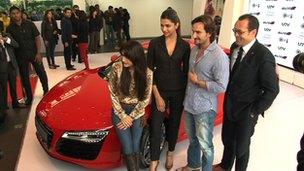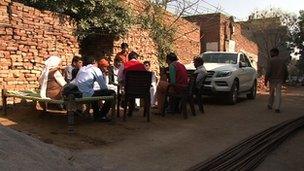India's luxury car boom fuelled by rural buyers
- Published
Western luxury carmakers are finding plenty of new buyers in India
Taking his family on a joy-ride around the town in his brand new Mercedes, Randhawa Sehrawat shows his kids what once used to be their wheat fields.
His children open up the sunroof to wave to their friends.
Their village of Sukhrali, like the rest of Gurgaon, has been transformed by India's economic growth and the Sehrawat family's fields are now the site of high-rises and shopping malls that dominate the landscape.
Mr Sehrawat's life, like other farmers in his village, used to depend on erratic monsoons.
But their lives took a dramatic turn as real estate developers, hungry for land in one of India's fastest-growing suburbs, came knocking on their doors.
And property prices here soared; the acres of farmland they owned turned farmers such as Mr Sehrawat into millionaires.
Buying his first car was an easy decision for the 29-year old.
"My grandfather always used to joke about it when I drove around in my bullock cart. He would ask why am I parading around like it's a Mercedes-Benz," he tells the BBC.
"Now I really have a Mercedes to drive around."
Boom town
Mr Sehrawat is not alone. Retailers say the majority of new car buyers in the area are farmers.
And the Delhi area which, along with the suburbs of Gurgaon and Noida, forms the National Capital Region (NCR), is the biggest market for luxury cars in India.
There is a flush of new money in these parts, and people living here are the new big spenders that luxury carmakers are now targeting in India.
One salesman recounts how he delivered a brand-new luxury SUV to a farmer in the middle of a mustard field as he was tending to his buffaloes.
And he paid for it with money stored in large potato sacks.
The luxury car market in India is expanding at annual rate of 40%, even as growth in the overall car market has stagnated in recent months.
Further growth
And what is getting the luxury car makers excited is the fact that the potential for growth in India is enormous.
Mercedes-Benz was the first to enter the Indian market. Last year the firm sold 7,138 cars in India, compared with 206,150 units in China.

Some car makers have been tapping into the appeal of Indian movie stars to boost sales
And with firms seeing slower growth in markets such as Europe and the US, India presents a great opportunity for them to keep their momentum going.
"The market in India is already quite big. It is nearly as big as the German market," says Eberhard Kern, managing director of Mercedes-Benz India.
"It is bigger than France or Italy or other markets that were developed a long time ago."
He adds that while the share of the premium and luxury cars is still a small one, it will definitely grow in the coming years.
"India is on our roadmap on one of the top positions. We look forward to what business we can do here."
Star appeal
According to a Confederation of Indian Industry-AT Kearney report, India's luxury market was worth $5.8bn (£3.7bn) in 2011 and is expected to treble by 2015.
The bulk of that spending goes towards the fast-growing luxury car market and firms are using all their resources to try and capture a bigger share.
Audi, for example, is using the charm and celebrity status of India's big-name movie stars to sell its cars.
An upcoming thriller movie titled Race 2, features a range of Audi cars in its action sequences.
The movie's stars even came to a Delhi showroom to promote the movie along with a new version of Audi's R8 Spyder car.
Targeting younger buyers, the company has seen its sales jump 63% last year.
The firm has also introduced a range of lower-priced models and is offering finance schemes to make it easier for young buyers to own luxury cars.
"With the financing scheme, we are tapping a new segment... we are seeing more and more salaried customers," says Michael Perschke, managing director of Audi India.
"They have invested in property, and schooling is taken care of, and now they are ready for luxury cars."
Made in India?
However, luxury carmakers are facing some hurdles as well, not least the high rates of taxation.
The Indian government levies a tax of more than 100% on imported luxury cars, pushing up their cost substantially.
But increasingly, car makers are making investments to assemble some units within India in an attempt to reduce the taxes as there is only a 10% tax on import of automobile parts.

Luxury cars are attracting a growing number of buyers from India's rural areas
Tata Motors, which now owns the British luxury brands Jaguar and Land Rover, is assembling the Jaguar XF in Pune in central India - reducing the price tag by over $20,000.
Market leader BMW, which sold more than 9,300 units by the end of 2012, is also planning to launch the new BMW 1 Series from its Chennai plant.
That should be good news for the likes of Mr Sehrawat.
As he sits with family sit outside their home on traditional string cots or charpoys in the winter sun, his 75-year old grandmother wants him to buy a luxury sport utility vehicle as his next vehicle.
A Range Rover would be a good idea, she says. Others nod in agreement.
Mr Sehrawat also agrees that it will be a good move as the four-wheel drive will be useful when he takes it to his fields.
Once bypassed by development, villages such as Sukhrali are now at the centre of it all.